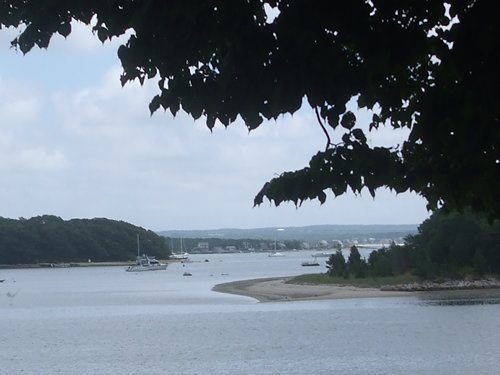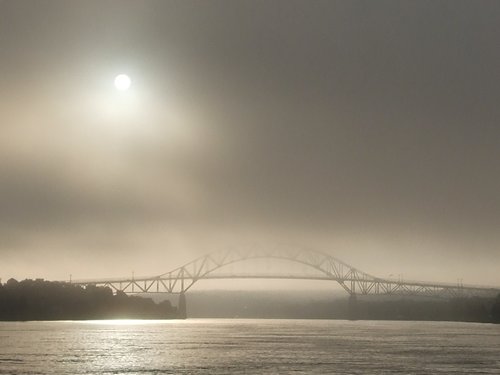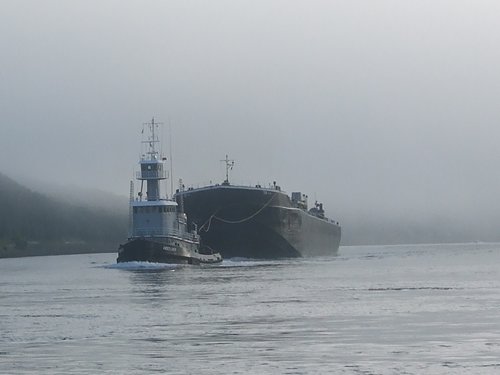Onset - Massachusetts and through the Cape Cod Canal

AJAYA'S CRUISE
Phil & Nikki Hoskins
Sun 11 Jul 2010 23:28
|
41:44.12N, 70:39.08W
We resisted the temptation to hum the old
BeeGees number about a certain State in the Union on the way to Onset. This
would be our only stop in Massachusetts as we need to push on quickly to
Maine. It's already into July and the summer season in Maine is July and
August. Of course some say "oh you must stay and see Maine in September - it's
beautiful" presumably because you can actually see it as the fog of
July & August has by then cleared away! We have spoken to many a
cruiser about what to expect when we get there, lobster pots and fog
are always vying for the No.1 slot of 'obstacles to be feared'
And of course there's the large amount of granite on the sea bottom to avoid if
possible. Anyway, September is not an option for us as we want to be south back
in the Chesapeake before any late hurricanes visit Maine which sits in
their way in the far north as a land mass curving eastwards out into the
Atlantic. It's known quite a few strikes over the years and this is reputed to
be a strong year so out we go by end of August. Beside all the jelly fish have
cleared out of the Chesapeake by then so swimming without being stung to
death becomes a possibility once again.
We motored most of the way to Onset catching two
more nice Bluefish on the way. In fact we could have filled the boat with them
as they seemed to be everywhere around us and feeding well not too
surprising there is a quota of 3 per boat. Once there we found a nice
little sea-side resort close to the Cape Cod Canal which the Americans kindly
built in the 19th century to avoid the long haul round the outside. In
World War 1 this was the hunting ground of many a U Boat especially when it was
known that the canal had been blocked by a ship that had been accidentally sunk
causing shipping to have to go the outside route.
We stayed in Onset for two nights, leaving a day in
the middle for exploring before getting up at a ridiculous hour to catch the
favourable tide eastwards through the 7 mile Cape Cod Canal. The difference
being if we didn't then it would take up to 3 hours to motor through
against a 3 knot current.
  Wickets Island just offshore with Onset
town beach in
foreground
another view taken just right of last pic with Ajaya far distant
centre
The anchorage off Wickets Island had good holding
which enabled us to leave the boat anchored whilst we headed to ashore to try
and check in by phone with the Homeland Security - a requirement whenever we
change between States. We later learnt that Wickets Island had once
been home to an Indian tribe. In more recent years a strong hurricane had
caused a huge tidal surge causing a lot of the island to be lost into the
surrounding water and during the process loads of old buried Indian
bones were washed into the sea. The locals kindly reburied them and Wickets
is now uninhabited.
It's a busy little resort with lots of day
visitors, an outside free film auditorium and a largish local population of Cape
Verdians who had sailed to Onset many years ago although we weren't sure why.
The well manicured sandy beach had lifeguards although being well away from the
open sea there was barely a ripple on the water so we guessed they were
there to deal with the odd heart attack when older citizens
braved the freezing cold water. We shopped at the local general store and
spent time browsing in a fascinating shop full of interesting locally made arts
and crafts and advertising evening belly dancing and meditation. Oh, and
displaying a book written by David Ike (so that's where the one copy went).
All in all, a pleasant place and useful as a
staging post to transit the canal.
The Cape Cod Canal
Our passage through was uneventful. It was misty
going on foggy, but not bad enough not to see a large barge and tow heading
towards us. The canal is now much wider than when built and boats can pass
easily unless very large in which case the canal authorities will use a traffic
light system to avoid potential disasters. At the western end is a railway
bridge where the central span over the canal is usually parked 150 feet in the
air on giant counterweights. A wonderful feat of engineering. We transited at an
average speed of 9 knots over the ground taking just under an hour, and
were 'spat out' the other end with a still favourable current. The forecast was
good so we decided to continue all the way to Penobscot Bay in Maine - some 140
miles to the north before a cold front exiting the eastern seaboard brought
northerly winds with it. Maine here we come.
  We thought these were nice shots of our
canal transit - no trick lenses - just normal colour settings mixed with a bit
of fog.
|